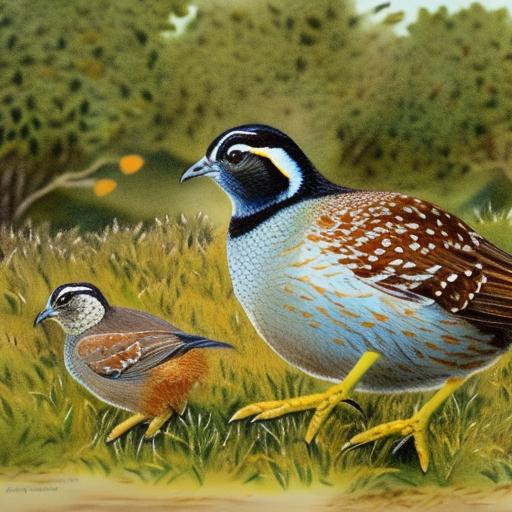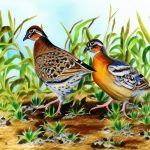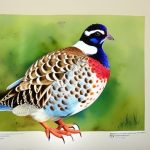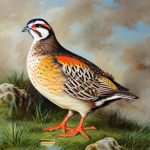California quail, also known as Valley quail, are popular game birds native to the western United States. They are known for their striking appearance, with a distinctive teardrop-shaped plume on their heads and a vibrant chestnut and blue-gray plumage. Breeding California quail can be a rewarding and enjoyable experience for bird enthusiasts and game bird breeders alike. Whether you are breeding quail for their beauty, for hunting purposes, or for conservation efforts, understanding the breeding process is essential for success.
Breeding California quail requires careful consideration of breeding stock, creating the ideal breeding environment, managing the breeding and incubation process, and caring for the chicks and young quail. Additionally, breeders must be prepared to address common challenges that may arise during the breeding process. This comprehensive guide will provide valuable insights and tips for successful California quail breeding, from selecting breeding stock to overcoming common challenges.
Key Takeaways
- California quail breeding requires careful selection of breeding stock and creating the ideal breeding environment.
- Breeding and incubation process involves providing proper care and monitoring the development of the eggs.
- Caring for chicks and young quail involves providing the right nutrition and protection from predators.
- Common challenges in California quail breeding include disease, predation, and maintaining the ideal breeding environment.
- Successful breeding tips include regular monitoring, providing proper nutrition, and addressing any health issues promptly.
Selecting Breeding Stock
Selecting the right breeding stock is crucial for successful California quail breeding. When choosing breeding stock, it is important to prioritize health, vitality, and genetic diversity. Look for birds that are active, alert, and free from any signs of illness or deformities. It is also essential to select birds with desirable physical traits, such as vibrant plumage and well-defined markings.
Genetic diversity is key to maintaining a healthy and robust breeding population. Avoid inbreeding by selecting breeding stock from different bloodlines to prevent genetic abnormalities and ensure the overall health and vigor of the offspring. Additionally, consider the temperament of the birds when selecting breeding stock. Choose birds that are calm and non-aggressive, as this will contribute to a harmonious breeding environment and reduce stress on the birds.
When selecting breeding stock, it is also important to consider the birds’ reproductive history. Look for birds that have a proven track record of successful breeding and healthy offspring. By carefully evaluating and selecting breeding stock based on health, genetic diversity, temperament, and reproductive history, breeders can lay a solid foundation for a successful California quail breeding program.
Creating the Ideal Breeding Environment
Creating the ideal breeding environment is essential for promoting successful breeding and ensuring the health and well-being of the quail. The breeding environment should mimic the natural habitat of California quail, providing them with ample space, suitable nesting sites, and appropriate food and water sources.
Quail aviaries or enclosures should be spacious enough to accommodate the breeding pairs comfortably. Provide plenty of hiding spots and cover to allow the quail to exhibit natural behaviors and reduce stress. Nesting boxes or shelters should be provided to give the quail a safe and secluded space for laying eggs and rearing their young.
The breeding environment should also offer a varied diet that includes high-quality game bird feed, fresh greens, and grit for digestion. Clean, fresh water should be readily available at all times to ensure proper hydration. Additionally, the breeding environment should be kept clean and free from any potential hazards or contaminants that could jeopardize the health of the quail.
By creating a well-designed and carefully maintained breeding environment that meets the natural needs of California quail, breeders can promote successful breeding behavior and ensure the overall health and well-being of their quail population.
Breeding and Incubation Process
The breeding and incubation process is a critical stage in California quail breeding that requires careful management and attention to detail. Breeding typically occurs in the spring when daylight hours increase, triggering hormonal changes in the quail that stimulate mating behavior. Breeding pairs should be observed closely for signs of courtship and mating activity.
Once mating has occurred, female quail will begin laying eggs in their nesting boxes or shelters. It is important to provide suitable nesting materials such as straw or grass to encourage egg-laying behavior. Collect the eggs daily to prevent them from being damaged or contaminated by other birds.
After collecting the eggs, they can be placed in an incubator set at the appropriate temperature and humidity levels for artificial incubation. Alternatively, some breeders may choose to allow the quail to incubate their eggs naturally. In either case, it is important to monitor the incubation process closely to ensure optimal conditions for embryo development.
During the incubation period, which typically lasts around 23 days, it is crucial to maintain stable environmental conditions and regularly monitor the development of the embryos. Proper turning of the eggs is essential to prevent deformities and ensure healthy chick development. Once the eggs hatch, provide a warm and safe brooding area for the chicks to thrive.
By carefully managing the breeding and incubation process, breeders can maximize the chances of successful hatching and ensure the health and vitality of the quail chicks.
Caring for Chicks and Young Quail
Caring for chicks and young quail requires attentive management to promote healthy growth and development. Immediately after hatching, chicks should be moved to a warm brooding area with access to heat lamps or brooders to maintain optimal temperature levels. Provide a balanced diet of high-quality game bird starter feed supplemented with small insects or mealworms to meet their nutritional needs.
It is important to monitor the chicks closely for signs of illness or weakness and provide prompt veterinary care if needed. Additionally, ensure that the brooding area is kept clean and dry to prevent disease and maintain good hygiene.
As the chicks grow, gradually introduce them to larger outdoor enclosures where they can acclimate to natural environmental conditions. Provide plenty of cover and hiding spots to reduce stress and encourage natural behaviors. Monitor their social interactions to ensure that they are getting along well with their peers.
As the young quail mature, continue to provide a balanced diet that meets their nutritional requirements for optimal growth and development. By providing attentive care and a suitable environment for young quail, breeders can promote healthy development and prepare them for successful integration into the adult quail population.
Common Challenges in California Quail Breeding

Despite careful management, breeders may encounter common challenges in California quail breeding that require proactive solutions. One common challenge is egg infertility or low hatch rates, which can be caused by factors such as inadequate nutrition, poor breeding stock quality, or environmental stressors. To address this challenge, ensure that breeding stock receives a balanced diet with proper nutrition and manage environmental conditions to minimize stress.
Another challenge is predation, as quail are vulnerable to predators such as raccoons, foxes, and birds of prey. Implement predator-proofing measures such as secure enclosures with sturdy fencing and predator deterrents to protect the quail from harm.
Disease outbreaks can also pose a significant challenge in quail breeding. To prevent disease, maintain strict biosecurity measures, practice regular cleaning and disinfection of enclosures, and monitor the health of the quail closely. In case of disease outbreaks, seek veterinary assistance promptly to implement appropriate treatment measures.
Additionally, managing aggression within the quail population can be challenging, especially during mating season or when introducing new birds. Provide ample space and hiding spots to reduce aggressive behavior and consider separating aggressive individuals if necessary.
By being proactive in addressing common challenges such as infertility, predation, disease outbreaks, and aggression, breeders can mitigate potential risks and promote successful California quail breeding.
Conclusion and Tips for Successful Breeding
In conclusion, California quail breeding can be a rewarding endeavor for bird enthusiasts and game bird breeders alike. By carefully selecting breeding stock based on health, genetic diversity, temperament, and reproductive history, creating an ideal breeding environment that meets the natural needs of quail, managing the breeding and incubation process with attention to detail, caring for chicks and young quail with attentive management, and addressing common challenges proactively, breeders can maximize their chances of successful California quail breeding.
To ensure successful breeding outcomes, consider these tips:
1. Prioritize health, genetic diversity, and reproductive history when selecting breeding stock.
2. Create a well-designed breeding environment that mimics the natural habitat of California quail.
3. Carefully manage the breeding and incubation process with attention to detail.
4. Provide attentive care for chicks and young quail to promote healthy growth and development.
5. Be proactive in addressing common challenges such as infertility, predation, disease outbreaks, and aggression.
By following these tips and implementing best practices in California quail breeding, breeders can enjoy a successful and fulfilling experience while contributing to the conservation and preservation of these beautiful game birds.
If you’re interested in learning more about breeding and incubation, you might also want to check out this article on the incubation period for goose eggs. It provides valuable insights into the process of hatching and raising geese, which can be helpful for poultry enthusiasts looking to expand their breeding knowledge beyond California quails.
FAQs
What is the breeding season for California quail?
The breeding season for California quail typically begins in late March and can extend through August, with peak activity occurring in May and June.
How do California quail build their nests?
California quail build their nests on the ground, often in a shallow depression lined with grass, leaves, and feathers. The female quail typically selects the nest site and constructs the nest.
How many eggs do California quail lay?
A female California quail can lay anywhere from 12 to 16 eggs in a single clutch, with an average of 14 eggs. The eggs are usually laid one per day until the clutch is complete.
How long does it take for California quail eggs to hatch?
The incubation period for California quail eggs is approximately 21 days. The female quail is responsible for incubating the eggs and keeping them warm until they hatch.
What is the role of the male California quail during the breeding season?
The male California quail plays a crucial role in protecting the nesting female and the eggs. He will often stand guard and alert the female to potential threats while she is incubating the eggs.
How long do California quail chicks stay with their parents?
California quail chicks are precocial, meaning they are able to leave the nest and feed themselves shortly after hatching. The parents will continue to care for and protect the chicks for several weeks until they are fully independent.
Meet Walter, the feathered-friend fanatic of Florida! Nestled in the sunshine state, Walter struts through life with his feathered companions, clucking his way to happiness. With a coop that’s fancier than a five-star hotel, he’s the Don Juan of the chicken world. When he’s not teaching his hens to do the cha-cha, you’ll find him in a heated debate with his prized rooster, Sir Clucks-a-Lot. Walter’s poultry passion is no yolk; he’s the sunny-side-up guy you never knew you needed in your flock of friends!







